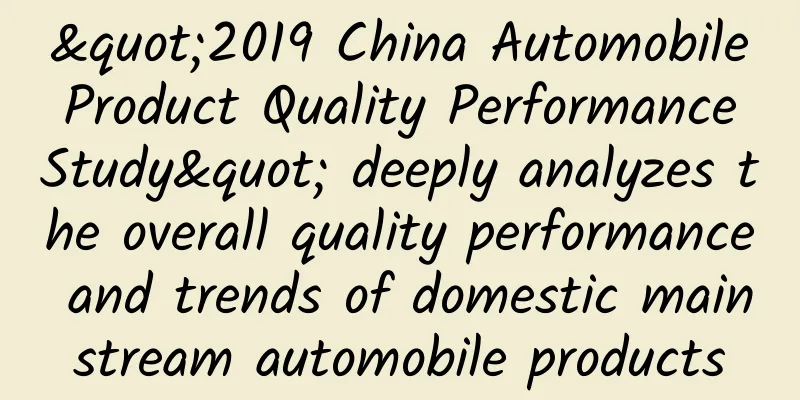"2019 China Automobile Product Quality Performance Study" deeply analyzes the overall quality performance and trends of domestic mainstream automobile products

|
In order to solve consumer pain points, help OEMs discover and improve quality problems, and help improve product quality in China's automotive industry, Kairui Saichi Consulting launched and released the "2019 China Automotive Product Quality Performance Research" report. From the user's perspective, we insist on problem-oriented research, conduct research and analysis from two dimensions: the number of problems and the degree of complaints, and deeply analyze the overall quality performance and trends of domestic mainstream automotive products. On April 20, Kairui Saichi Consulting officially released the heavyweight industry research report "2019 China Automotive Product Quality Performance Research". According to reports, the research project was officially launched in March 2019. During the one-year investigation, the researchers always took problem-oriented as the criterion, and took the consumer perception perspectives such as complaint coefficient and negative quality performance as the main line, and deeply analyzed the overall quality performance and trends of domestic mainstream automotive products, aiming to explore user needs, help vehicle manufacturers develop new models and the high-level development of the industry's overall quality system. Adhering to the problem-oriented approach is a process of discovering problems, analyzing them scientifically, and working hard to solve them. In the current quality research field of the automotive industry, traditional research methods generally have shortcomings such as low sensitivity of consumers in random surveys to problems, few in-depth inquiries into the background of quality problems, and a lack of a process to distinguish the severity of problems. These shortcomings have limited substantive reference effects on vehicle manufacturers in solving quality problems. The "China Auto Product Quality Performance Study" will focus on the real-name customer complaints collected by Chezhi.com. This type of user is more sensitive to automobile quality issues. The staff found in the survey that this user group has a relatively high understanding of quality issues, and has their own opinions and thoughts on the location, phenomenon, and even causes of the problem. This can prevent general users from misleading the research results and the judgment of vehicle manufacturers due to misunderstandings of the problem. These characteristics cannot be reflected in the traditional survey method based on the number of failures per 100 vehicles, which is also a subversive advantage of the research report released this time. Chezhi.com is the most influential automobile product quality information collection platform in China. The various data it publishes, such as the vehicle model complaint rankings, have always been an important basis for consumers to purchase vehicles. However, due to the different ownership and sales bases of different products, any statistics based on absolute numbers are relatively insufficient. The automobile product quality performance research has played a good role in correcting the relevant data. This study successfully surveyed more than 20,000 car users, involving 18 market segments, 53 brands and 128 models, basically covering the main models on sale in the first half of 2019. The data shows that in terms of the most important quality problem dimension, the surveyed users mentioned a total of 339 quality problems during vehicle use. The final performance of each model is presented in the value of "negative quality performance", and the two are inversely proportional. That is, the smaller the negative quality performance value, the better the final performance of the model, and the higher the ranking. During the survey, the researchers focused on representative users and accurately identified various quality issues. In response to these issues, they dug into data from multiple dimensions such as mileage, location, and supply chain, asked additional questions about the complaints of the survey participants, and differentiated the levels. They creatively proposed the concept of "complaint coefficient", and finally presented in-depth information such as the attitudes of the surveyed groups towards different quality issues. The research results highlight unique and rich value, and are highly practical for automakers to improve their quality system construction. Among the top 20 quality problems in the industry, "transmission noise", "shifting jerks" and "strange smell in the car" ranked in the top three. Dynamic problems were more than static problems, and the number of perception-related problems was much higher than that of fault-related problems. The average number of quality issues in the industry in this quality survey was 4.12, of which failure issues accounted for 27% and perception issues accounted for 73%. Only the sedan market has a higher number of quality issues per vehicle than the industry average. Pickup trucks perform the worst among all markets, and the proportion of pickup truck failures is also the highest. The industry average negative quality performance is 24.49, and only sedan models are better than the industry average. Due to the large complaint coefficient, the negative quality performance of MPV and pickup models is poor. The complaint coefficient of new energy vehicles is the lowest among all models. The quality problems are divided according to the location where they occur. Driving system, engine and appearance are the top three quality problems. The number of dynamic quality problems is higher than that of static quality problems, but the difference between dynamic and static is not large. The ranking of negative quality performance of each part has changed compared with the number of quality problems. The gearbox has risen from fourth place to third place, replacing the appearance. Consumers have the highest complaint coefficient for engine and gearbox related problems. After segmenting the sedan and SUV markets, it was found that the average number of quality problems per sedan was 3.66, of which 28% were fault problems and 72% were perception problems. Small sedans performed the worst, with the fault ratios of both small and medium-sized sedans exceeding 30%. The average negative performance of sedans is 21.59, and only medium and large sedans are better than the average in each market segment. Compared with other market segments, small sedans have a higher complaint coefficient and the negative performance of dynamic parts is poor. The average number of quality issues per SUV is 4.33, of which 29% are fault issues and 71% are perception issues. Among them, small SUVs and compact SUVs perform worse than the market average, while medium and large SUVs have a higher proportion of fault issues. The average negative performance of SUV quality is 25.92, and the mid-sized SUV and medium-large SUV segments are better than the average. Compared with other segments, small SUV models have the lowest complaint coefficient. The car models are divided into three levels according to the country of origin. The number of quality problems of sedans and SUVs is mainly divided into three levels, among which the domestic brands have the most problems and the largest proportion of fault problems. The second level is Korean, American and German models, and Japanese models perform best. Since the complaint coefficient of American and German models is higher, and the complaint coefficient of Korean models is lower, the performance of Korean models with more quality problems in this dimension has improved. The performance of the market segments is explained in detail. Among the small sedan models of various countries, the number of quality problems, complaint coefficients, and negative quality performance of American models are the worst, and the proportion of failure problems of American models is the highest. The Top problem of the small sedan is explained in detail. The first problem is the abnormal noise of the gearbox. We found that a certain American model had multiple problems with the gearbox, among which the abnormal noise of the gearbox had the highest probability of feedback, accounting for 27% of the model feedback, and was accompanied by difficulties in shifting gears and shaking of the gear lever. This problem occurred in both MT and AMT models, and it broke out at all mileages. According to the data from the complaint platform, the previous generation of models in this series had this problem, but the problem was not solved when the model was replaced. Another problem with small cars is abnormal engine idle speed. We found that when a certain Japanese car model was idle in D gear at the quasi-new stage, the engine speed gradually decreased to 500rpm, which was inconsistent with the normal state of the car. In addition, some vehicles were accompanied by vehicle shaking or even flameout. Some car owners chose to return to the store to clean the throttle, but the problem still existed. In the compact car market, Korean models have the worst quality problems, complaint coefficient, and negative quality performance. The remaining countries with negative quality performance are domestic models, German models, and Japanese models, and the best performance is American models. Two typical problems of Korean compact cars are selected. The first problem is tire bulging. Tire bulging has become the largest single quality problem in the quality survey and complaint platform of a certain Korean car model. According to statistics, the tire bulging problem of this car model occurs on the front wheel, mainly with 225/45 R17 tire model, and there are problems with both matching tire brands and mileage. Another problem is vehicle deviation. A certain Korean model has a problem with new or nearly new cars deviation. According to statistics, nearly new cars with a mileage of less than 10,000 kilometers account for 58%, and 97% of them deviate to the right. According to the description, some car owners discovered this problem when they drove out of the door after picking up the car from the 4S store, which had a direct negative impact on the model and the Korean brand. This problem has not been solved in the latest model (2018 model), and a total of 18% of the surveyed users reported that they had encountered the problem of deviation. Next is the mid-size sedan market. Japanese mid-size sedans performed much better than American and German models. Configuration location appeared for the first time in the top 10 mid-size sedan issues. American models performed the worst in this market, and two typical problems of American models are explained in detail. The odor in the car is the biggest single quality problem of a certain American brand in this quality survey, and a total of 16.8% of the brand's users reported encountering such problems. Combined with the data from the complaint platform, the problems are mainly concentrated in the brand's compact sedans, mid-size sedans, and compact SUV models. Taking the brand's mid-size sedan as an example, the problems are mainly concentrated in the first 2013 model of the fourth generation. The problems of the new models have decreased, but the problems still exist. Another problem is the door noise. A certain American car model had a door noise problem when it was on a bumpy road. According to statistics, this problem has no direct relationship with the model year or durability, and all four doors have problems. This problem may be related to insufficient rigidity of the door or body, squeezing the door seal strip and causing the noise. Forums, car clubs and other groups have short-term solutions, but they cannot cure it. In the mid-to-large sedan market, audio and video entertainment issues are more common, and American models perform the worst. Central control system failure is the largest single quality problem in a certain American brand's vehicle quality survey and complaint platform, and is also the brand's biggest problem. Taking the brand's mid-to-large sedan as an example, this problem broke out in the 2013 and 2014 models, and it still occurs in the new models. So far, more than 60% of complaints about central control system quality problems occurred after the vehicle warranty expired. Another typical problem is abnormal brake noise. Abnormal brake noise has become a common quality problem in the three models surveyed by a German brand. A total of 29% of the brand's users reported that they had encountered such problems. This problem has nothing to do with the year of the car and the mileage. The problem exists when the car is newly purchased, and the quality problem has not decreased with the increase in mileage. It is particularly serious at low speed and when the car is cold, causing great trouble to the car owners. Small SUV models encounter more problems with the driving system, and due to their low displacement, the lack of engine power after turning on the air conditioner has become the most popular problem in this market segment. The problem of body rust is more common in domestic brands, especially in the small SUV market. All domestic models surveyed have body rust problems, and the highest probability of the model is 24%. The data shows that 56% of the models were found to be rusted within 1-3 years after purchase, and the rear door rust has the highest proportion, accounting for 33%. The main manifestations are rust on the contact parts between the car logo/decorative strips and the body, and corrosion of the base of the inner panel. The preliminary judgment is that the paint film adhesion of the rear door is poor, which greatly reduces the anti-corrosion performance, thus causing base corrosion. Another typical problem occurred in 40% of a certain model. A certain domestic brand model had excessive wear of new car tires, and the model had a high proportion of feedback, with a total of 40% of users reporting that they had encountered this problem. 41% of the problems in the surveyed models occurred within 3,000 kilometers of mileage, and this problem was found in models from 2014 to 2017, but not in the 2018 models currently on sale. In the compact SUV market, American models have the worst number of quality problems, complaint coefficient, and negative quality performance, and domestic models have the highest proportion of failure problems. Abnormal noise from shock absorbers is the single largest quality problem in the quality survey and complaint platform of a certain compact SUV, with a survey feedback rate of 45% and a complaint platform share of 43%. This quality problem is reflected in all years of this model. This model currently ranks third in complaints about domestic SUVs, with a poor performance. However, if there is no abnormal noise from shock absorbers, this model will only rank 8th. Among mid-size SUVs, domestic models performed the worst, while Japanese models performed the best. Germans are the worst performing country for joint venture mid-size SUVs. Regarding the specific problems of Germans, abnormal noise from the sunroof has become a common quality problem for two models of a German brand surveyed, with a total of 17% of users of the brand reporting that they have encountered such problems. All vehicles with the problem are equipped with panoramic sunroofs, and models with small sunroofs do not have this problem. This problem has little to do with mileage, with 62% of vehicles with the problem having a mileage of less than 3,000 kilometers, and some owners even have abnormal noise from the sunroof on new cars. In the mid-to-large SUV market, domestic and German models performed poorly, while Japanese models performed best. Like mid-to-large sedans, audio and video entertainment issues also appeared in the top 10 list of mid-to-large SUVs. Owners of medium and large SUV models of a certain domestic brand reported that the problem of water vapor in the headlights was concentrated. This problem occurred at all stages of vehicle mileage, and even in the quasi-new stage within 10,000 kilometers, there was still a 38% probability of occurrence. This problem occurred not only in the headlight parts, but also in the fog lights, turn signals, and reverse lights. I will not give specific examples of the MPV, new energy and pickup truck markets, but only list the results and the top issues. Based on the above results, this study has 6 recommendations for improving product quality. First, improve the product quality of cheap models. In the various market segments of sedans and SUVs, the quality of small cars is poor. This shows that consumers have not lowered their requirements for products too much because of the low price of cars. Therefore, the product quality of all models should be improved, especially cheap models. Second, eliminate new car quality problems. Abnormal idling, tire bulges and other quality problems often occur within 10,000 kilometers, and even vehicle deviation quality problems have already appeared when the car is picked up. Quality problems with new/nearly new cars are more likely to cause users to complain and have negative emotions about the entire brand. OEMs need to better investigate product quality problems when the whole vehicle is tested off the assembly line. Third, prevent quality problems from becoming a brand label. Some of the quality problems that have occurred in the past will become a brand label, thus affecting the sales of new models. Even if the new model has solved the problem, the brand label will not diminish. OEMs should not have a fluke mentality on quality issues and should take every quality issue seriously. Fourth, pay attention to the quality issues of high-end configurations. There are many quality issues with panoramic sunroofs, human-computer interaction and other configurations. With the increase in the number of models equipped and the lower end of the market, the quality issues of high-end configurations will explode on a large scale in the future, and OEMs need to make quality control and emergency measures in advance. The fifth point is the direction of improvement for domestic brands. For the same quality problem, the complaint coefficient of domestic brand car owners is generally low, which shows that domestic brand car owners have a certain tolerance for the quality problems of their models. In the next stage, domestic brands need to reduce the number of their own quality problems and get rid of the label of "many problems", so that the final quality performance can be improved. The sixth point is the direction of improvement for joint venture brands. In contrast to domestic brands, consumers have higher quality expectations for joint venture brands, so when quality problems occur, complaints are greater. Joint venture brands should give priority to solving the number of quality problems in the engine and transmission dimensions that consumers are easily aware of and complain about the most, so as to improve the final quality performance. The following is a list of the best performing models in each market segment. First, here is an overview of the results. We found that compared with joint venture brands, domestic brands have some advantages in terms of complaint coefficient, but the number of quality problems has increased a lot. Finally, the ranking of each model is based on the negative quality performance dimension. The current mainstream automotive product reputation/quality research products in the market cannot deeply match consumers' real perception of automotive product defects, so manufacturers have no way to capture and improve them. Therefore, the research results released this time will be more important in timely grasping the psychological and behavioral changes of consumers in product quality performance over the past year. In fact, the product quality control practices of domestic automobile manufacturers mostly follow the problem-oriented principle, and have a strong demand for accepting the real feelings of users. During the discussion process before the launch of this survey, many automobile companies expressed their desire to see in-depth research results that can truly discover and solve problems. There is no doubt that as the largest domestic platform for collecting information on customer complaints about automobile product quality, Chezhi.com has irreplaceable advantages in discovering consumer sensitive factors. As a professional organization, Kairui Saichi Consulting uses precise data as its research object, and objectively and scientifically classifies and studies the degree of user complaints. The final survey results show that both the problems found and the quality performance of the models are highly consistent with the cognition of most automobile consumers and the consensus of the industry. It is an industry quality research report that can withstand verification and scrutiny. Based on comprehensive research and judgment of the market and industry, Kairui Saichi Consulting has launched the "2020 China Auto Product Quality Performance Study". It is understood that the 2020 study will dynamically update the market segments and model database, optimize the quality evaluation dimensions, and provide enterprises and industries with trend-based product strategy references that are closer to users with more diverse research methods. |
Recommend
Have you ever seen this "colorful black" dinosaur?
Your browser does not support the video tag At fi...
Soul advertising, Soul advertising billing model
Soul is a new generation social APP whose audienc...
Is it expensive to develop a mini program for daily necessities in Zhuhai? Zhuhai daily necessities applet development process and cost
There is no doubt that the topic of mini programs...
Why Google was fined a record 4.3 billion euros by the European Union
[[237085]] On July 18, at 7:00 pm Beijing time, t...
KOL marketing IPization!
This is a golden sentence said by the star Ning J...
7 major performances: Android mobile desktop operation monetization method 1: application download
What is mobile desktop ? In fact, there is no sta...
Why are the lakes in scenic spots green? Is it the reflection of the trees? Actually, it’s thanks to this!
The guest road is beyond the green mountains, and...
Is there anything worth looking forward to about Apple TV, which has not been abandoned by Apple?
There are less than ten days left before the much...
Brand war under the epidemic
We all know that the former chairman of Coca-Cola...
YunOS has developed to the third generation. Official statement: We must do it no matter how difficult it is.
Recently, Alibaba Group officially announced the ...
Catnip: You never imagined it, humans, but I am the "master" of your cat master
For many cats, the smell of catnip can easily mak...
Here will be another major scientific facility! How will the world's first "zero magnetic" space expand the boundaries of humankind?
Large scientific facilities are called "the ...
Five features that iPhone 7 needs to add to save sales
According to the technology website ZDNet, two mon...
What changes will occur in your body if you eat and drink heavy-tasting food for a long time?
The pace of life is fast nowadays, and many peopl...
How to use data to drive scale growth?
The data system is not only the basis of your sci...









